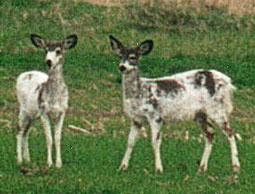Diseases and Parasites of Maryland Deer
Main_Content
Piebald Anomaly
(This is not a parasite or disease.) |
|

Photograph depicting two piebald deer
|
|
A genetic variation (defect) produces the piebald condition in white-tailed
deer, not parasites or diseases. Piebald deer are colored white and brown
similar to a pinto pony. Sometimes they appear almost entirely white. In
addition to this coloration, many have some of the following observable
conditions: bowing of the nose (Roman nose); short legs; arching spine
(scoliosis); short lower jaws. This genetic condition is rare with typically
less than one percent of white-tailed deer being affected.
|
Acknowledgements:
Photographs are used with the permission of the Southeastern
Cooperative Wildlife Disease Study located at the University of Georgia,
College of Veterinary Medicine.
For more information about white-tailed deer parasites and diseases, visit the Southeastern Cooperative Wildlife Disease Study Web site.
The publication “Field Manual of Wildlife Diseases in the Southeastern
United States” (third edition) by William R. Davidson and Victor F.
Nettles explains and describes in detail parasites and diseases of
southeastern birds and mammals. It is available for purchase through
the website listed above.
Maryland Department of Natural Resources
Wildlife and Heritage Service
Tawes State Office Building, E-1
Annapolis MD 21401
410-260-8540
Toll-free in Maryland: 1-877-620-8DNR, Ext. 8540
E-Mail: [email protected]